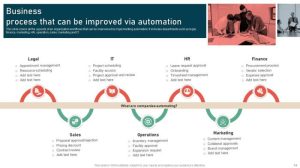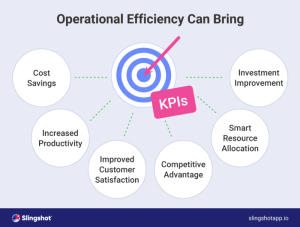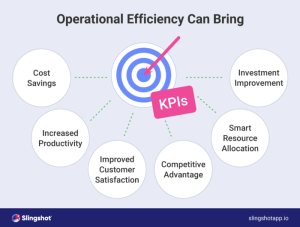As Key Metrics for Operational Efficiency takes center stage, this opening passage beckons readers into a world crafted with good knowledge, ensuring a reading experience that is both absorbing and distinctly original. In the realm of business operations, understanding and utilizing key metrics is paramount to achieving optimal efficiency and success.
Businesses rely on specific metrics to measure and enhance their operational efficiency, paving the way for streamlined processes and improved performance. Let’s delve deeper into the realm of operational efficiency metrics and explore their significance in driving business growth.
Understanding Operational Efficiency
Operational efficiency in the context of business operations refers to the ability of an organization to utilize resources effectively in order to maximize output while minimizing waste. It involves streamlining processes, reducing costs, and improving overall productivity.Operational efficiency is crucial for businesses as it directly impacts profitability, competitiveness, and sustainability. By optimizing operations and eliminating inefficiencies, organizations can enhance their bottom line, deliver better products or services to customers, and adapt more quickly to changing market conditions.
Importance of Operational Efficiency
- Cost Reduction: Improved operational efficiency leads to reduced expenses, which can boost profitability.
- Enhanced Productivity: Streamlining processes can increase output without the need for additional resources.
- Competitive Advantage: Efficient operations allow businesses to offer better pricing or superior products/services compared to competitors.
- Adaptability: Efficient organizations can respond quickly to market changes and customer demands, staying ahead of the competition.
Efficiency is doing things right; effectiveness is doing the right things.
Peter Drucker
Examples of Operational Efficiency Impact
- A manufacturing company implements lean principles to reduce waste in its production process, leading to lower costs and faster delivery times.
- An e-commerce retailer optimizes its supply chain management, resulting in quicker order fulfillment and improved customer satisfaction.
- A software development firm automates repetitive tasks, allowing developers to focus on innovation and product improvement, leading to higher quality software releases.
Key Metrics for Operational Efficiency

In order to measure operational efficiency, businesses rely on specific key metrics that provide valuable insights into their performance and productivity. These metrics help organizations identify areas for improvement and make data-driven decisions to streamline operations and maximize efficiency.
1. Overall Equipment Effectiveness (OEE)
Overall Equipment Effectiveness (OEE) is a key metric used to evaluate the performance of equipment in a production environment. It takes into account three factors: availability, performance, and quality, to determine the overall efficiency of the equipment.
OEE = Availability x Performance x Quality
Businesses calculate OEE by multiplying the availability, performance, and quality percentages. This metric helps organizations identify downtime, speed loss, and defect rates, allowing them to optimize equipment utilization and improve productivity.
2. Cycle Time
Cycle time is another important metric that measures the time it takes to complete a specific task or process. By analyzing cycle times, businesses can identify bottlenecks, inefficiencies, and areas for improvement in their operations.
Cycle Time = Total Processing Time / Total Number of Units
Organizations use cycle time data to optimize processes, reduce lead times, and increase overall efficiency in their operations. By reducing cycle times, businesses can enhance productivity and meet customer demands more effectively.
3. Inventory Turnover Ratio
The inventory turnover ratio is a metric that evaluates how efficiently a business manages its inventory. It measures the number of times inventory is sold and replaced within a specific period, indicating the effectiveness of inventory management practices.
Inventory Turnover Ratio = Cost of Goods Sold / Average Inventory
By analyzing the inventory turnover ratio, organizations can identify slow-moving inventory, reduce carrying costs, and improve cash flow. This metric helps businesses optimize inventory levels and enhance operational efficiency.
Monitoring and Tracking Operational Efficiency
Monitoring and tracking operational efficiency is crucial for businesses to ensure optimal performance and identify areas for improvement. By utilizing various methods and tools, companies can effectively analyze key metrics to make informed decisions and enhance overall operations.
Methods and Tools for Monitoring
- Utilizing Key Performance Indicators (KPIs) to measure and track important metrics such as production output, resource utilization, and customer satisfaction.
- Implementing data analytics software to collect and analyze data in real-time, providing valuable insights into operational performance.
- Conducting regular operational audits to evaluate processes, identify bottlenecks, and optimize workflows for increased efficiency.
Frequency of Analysis
Businesses should analyze operational efficiency metrics on a regular basis to stay informed about performance trends and potential issues. The frequency of analysis may vary depending on the industry and specific business needs, but a general rule of thumb is to conduct reviews monthly or quarterly.
Best Practices for Continuous Monitoring
- Establish clear goals and benchmarks to measure operational efficiency against, allowing for meaningful comparisons and progress tracking.
- Automate data collection processes to ensure accurate and consistent monitoring without manual intervention.
- Regularly communicate performance results to relevant stakeholders to foster accountability and drive continuous improvement efforts.
Improving Operational Efficiency

Improving operational efficiency is crucial for businesses looking to optimize their processes and maximize productivity. By identifying and addressing inefficiencies, businesses can streamline their operations and achieve better results. Let’s explore strategies for improving operational efficiency.
Identifying Inefficiencies in Business Operations
Before businesses can improve their operational efficiency, they need to first identify areas of inefficiency within their operations. This can be done through a thorough analysis of processes, workflows, and performance metrics.
- Conduct regular audits and assessments to pinpoint bottlenecks or areas of waste.
- Seek feedback from employees who are directly involved in day-to-day operations.
- Utilize technology and data analytics to uncover patterns and trends that indicate inefficiencies.
Streamlining Processes to Improve Operational Efficiency
Once inefficiencies have been identified, businesses can implement strategies to streamline processes and improve operational efficiency.
- Automate repetitive tasks to reduce manual errors and save time.
- Implement lean methodologies to eliminate waste and optimize resource utilization.
- Invest in employee training and development to enhance skills and productivity.
Real-World Examples of Successful Operational Efficiency Improvements
Many businesses have successfully improved their operational efficiency through strategic initiatives and innovative approaches. Here are some real-world examples:
“Company XYZ reduced production costs by 20% by implementing a new inventory management system that optimized supply chain processes.”
“Retailer ABC improved customer satisfaction by 15% by streamlining their order fulfillment process and reducing delivery times.”
“Manufacturer DEF increased production output by 30% by reorganizing factory layout and implementing workflow improvements.”
In conclusion, Key Metrics for Operational Efficiency play a crucial role in guiding businesses towards enhanced productivity and profitability. By monitoring, tracking, and improving these key metrics, organizations can unlock their full potential and stay ahead in today’s competitive landscape.
Answers to Common Questions
What are some common key metrics used to measure operational efficiency?
Some common key metrics include cycle time, throughput, capacity utilization, and overall equipment effectiveness (OEE).
How frequently should businesses analyze operational efficiency metrics?
Businesses should ideally analyze these metrics on a regular basis, whether monthly, quarterly, or annually, depending on the nature of their operations.
What are some strategies for identifying inefficiencies in business operations?
Strategies include conducting process audits, implementing automation, leveraging technology, and actively seeking feedback from employees.




